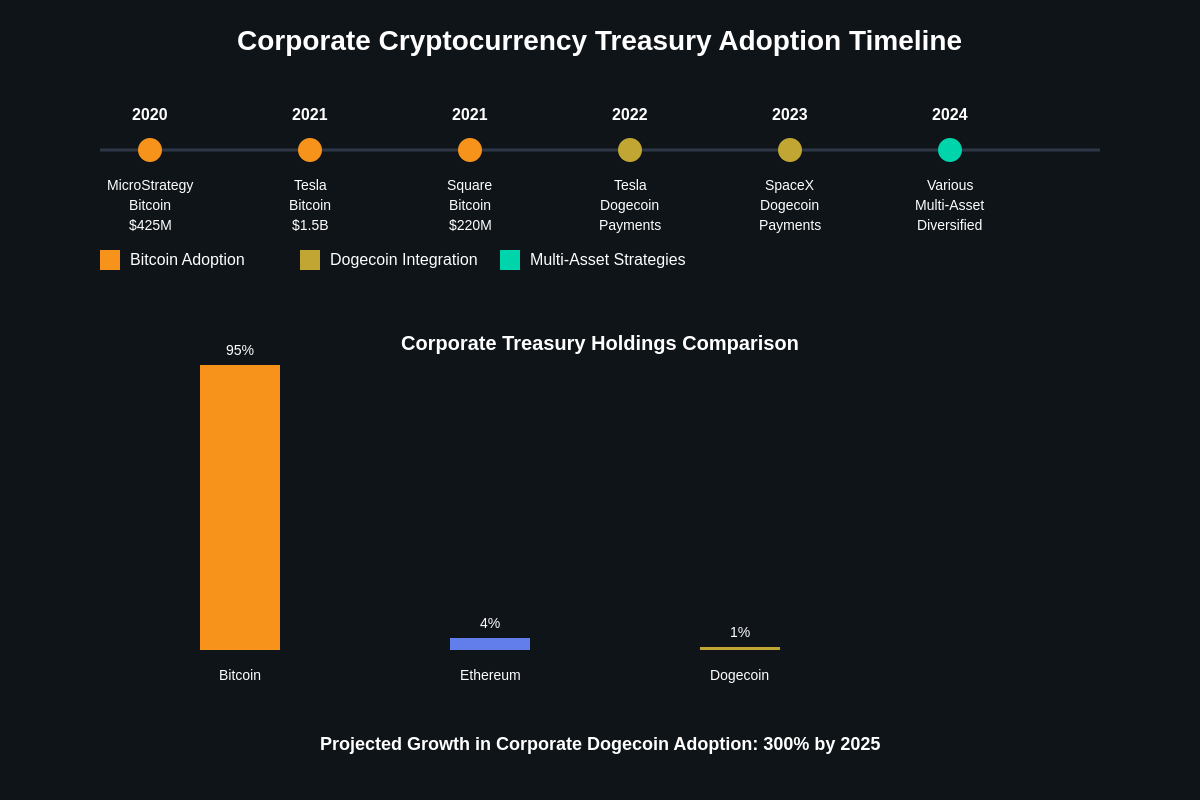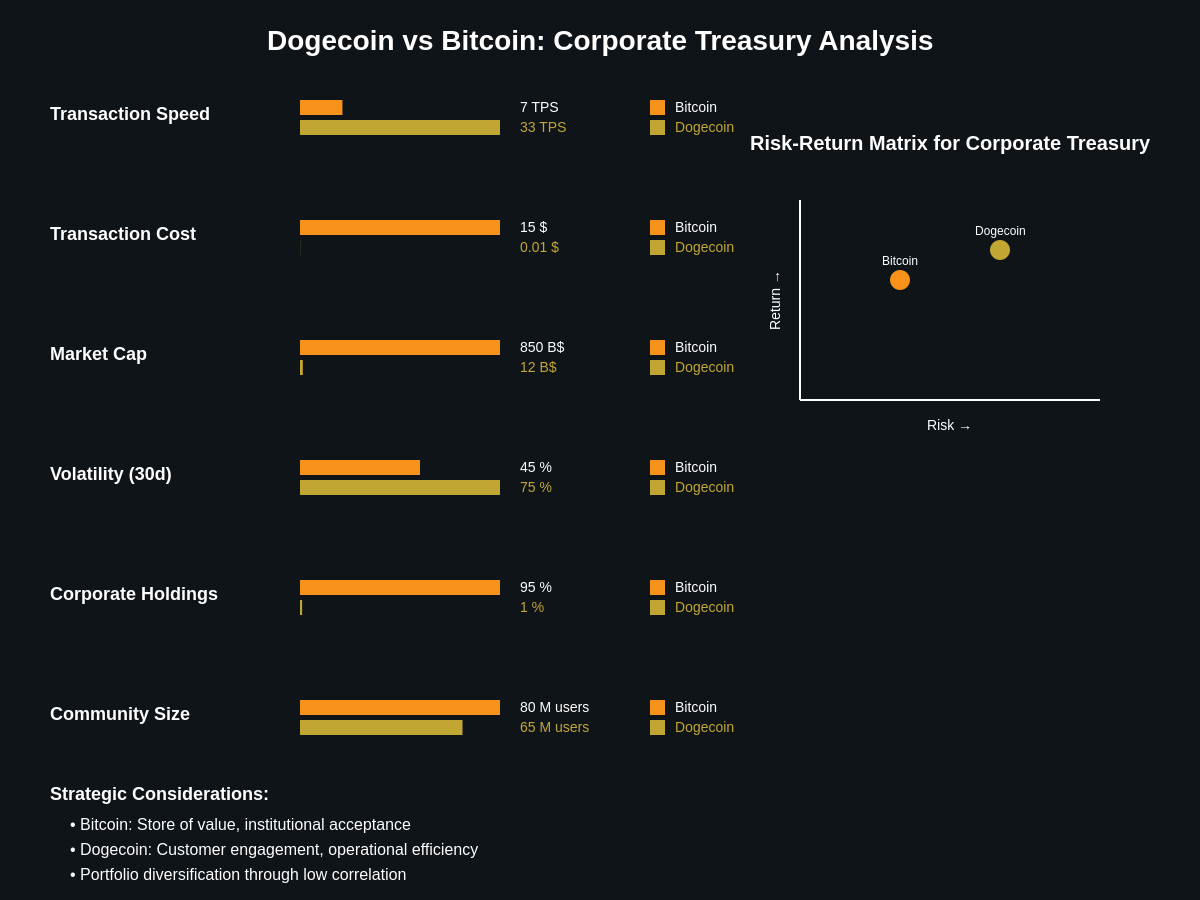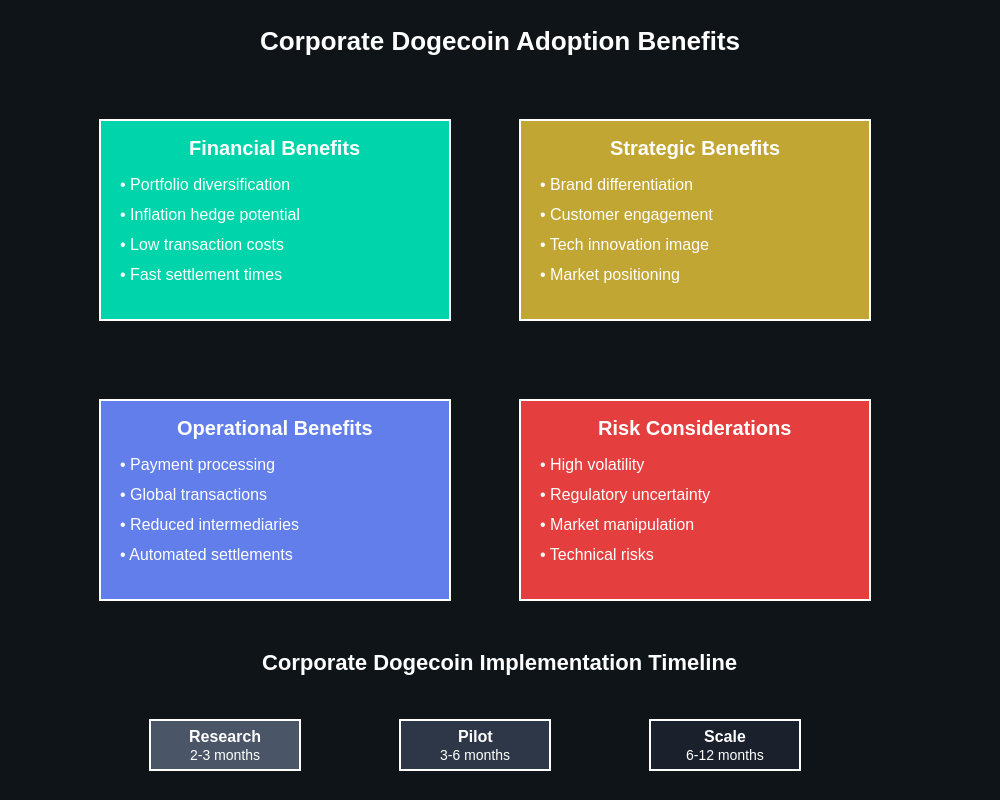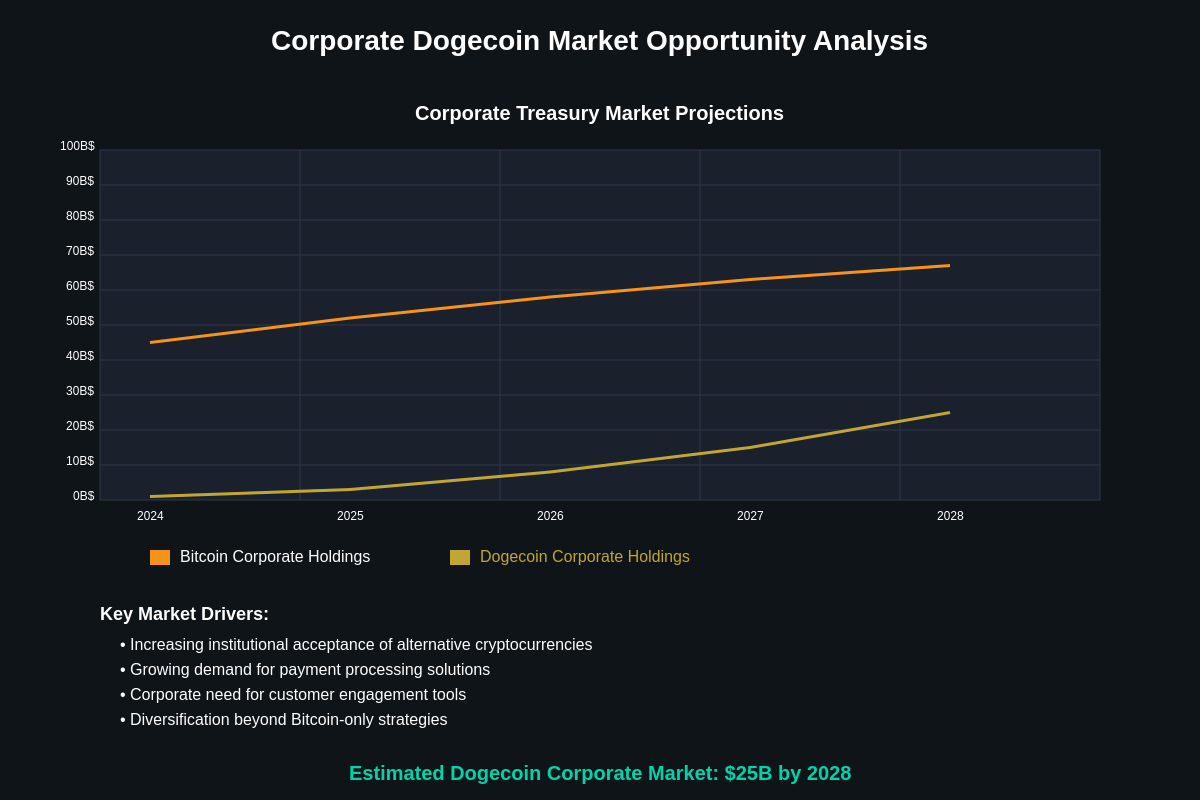The Evolving Perception of Digital Currency Reserves
The cryptocurrency landscape has undergone a fundamental transformation as corporate treasurers increasingly recognize the strategic value of digital assets beyond traditional store-of-value narratives. While Bitcoin has long dominated corporate treasury conversations since MicroStrategy’s groundbreaking adoption in 2020, a surprising contender has emerged in the form of Dogecoin, challenging conventional wisdom about what constitutes appropriate corporate treasury assets. This shift represents more than just diversification strategy; it reflects a deeper understanding of how meme-driven digital currencies can serve legitimate business purposes while capturing unique market opportunities that traditional assets cannot provide.
The journey from Bitcoin’s initial corporate adoption to Dogecoin’s emerging treasury consideration illustrates the maturation of digital asset markets and the evolution of corporate risk management frameworks. Companies that once viewed cryptocurrency with skepticism are now developing sophisticated strategies for incorporating multiple digital assets into their treasury operations, driven by factors including inflation hedging, technological innovation exposure, and customer alignment strategies that extend beyond pure financial metrics.

Historical Context of Corporate Cryptocurrency Adoption
The corporate adoption of cryptocurrency as a treasury asset began with pioneering companies like MicroStrategy, Tesla, and Square, which collectively added billions of dollars worth of Bitcoin to their balance sheets between 2020 and 2021. These early adopters faced significant regulatory uncertainty, accounting complexities, and market volatility while establishing precedents that would influence subsequent corporate cryptocurrency strategies. The success and challenges of these initial Bitcoin adopters created a framework for evaluating other digital assets, including the criteria that companies now use to assess alternative cryptocurrencies like Dogecoin for treasury purposes.
Bitcoin’s corporate adoption was driven primarily by its perception as digital gold, offering protection against monetary debasement and providing exposure to the growing cryptocurrency ecosystem. Companies justified Bitcoin purchases through narratives focused on store of value characteristics, limited supply dynamics, and increasing institutional acceptance that positioned Bitcoin as a legitimate alternative to traditional treasury assets. The performance of these early Bitcoin positions, while volatile, generally validated the strategic rationale for corporate cryptocurrency adoption and established important precedents for accounting treatment, regulatory compliance, and shareholder communication strategies.
The lessons learned from Bitcoin’s corporate adoption phase have directly influenced how companies evaluate other cryptocurrencies for treasury purposes, creating evaluation frameworks that consider factors beyond traditional financial metrics. These frameworks now incorporate considerations such as community strength, technological innovation potential, brand alignment opportunities, and strategic marketing value that make Dogecoin an increasingly viable candidate for corporate treasury consideration despite its origins as a meme cryptocurrency.
Dogecoin’s Evolution from Meme to Legitimate Asset
Dogecoin’s transformation from internet meme to serious financial asset represents one of the most remarkable narratives in cryptocurrency history, fundamentally challenging assumptions about what constitutes legitimate digital currency value. The cryptocurrency that began as a joke based on a popular internet meme has evolved into a digital asset with substantial market capitalization, widespread merchant acceptance, and growing institutional recognition that positions it as a credible alternative to Bitcoin for certain corporate treasury applications.
The community-driven nature of Dogecoin has created unique characteristics that differentiate it from Bitcoin and other cryptocurrencies, including lower transaction costs, faster confirmation times, and a more accessible user experience that appeals to mainstream consumers. These technical advantages, combined with strong brand recognition and cultural relevance, have attracted attention from companies seeking to align their treasury strategy with customer engagement and marketing objectives that extend beyond pure financial performance metrics.
Corporate interest in Dogecoin has been significantly influenced by high-profile endorsements from business leaders like Elon Musk, whose companies Tesla and SpaceX have both accepted Dogecoin for certain transactions and demonstrated ongoing support for the cryptocurrency’s development and adoption. These endorsements have lent credibility to Dogecoin’s potential as a corporate treasury asset while highlighting how executive leadership can drive cryptocurrency adoption decisions that balance financial strategy with brand positioning and customer engagement objectives.
Current Corporate Treasury Landscape
The current corporate cryptocurrency treasury landscape reflects a more sophisticated understanding of digital asset risk management and portfolio construction, with companies developing nuanced strategies that incorporate multiple cryptocurrencies based on different strategic objectives. While Bitcoin remains the dominant corporate treasury cryptocurrency, representing the vast majority of corporate digital asset holdings, companies are increasingly exploring diversification strategies that include alternative cryptocurrencies with different risk-return profiles and strategic benefits.

Recent corporate treasury analysis on TradingView demonstrates growing interest in cryptocurrency diversification strategies that extend beyond Bitcoin to include assets like Ethereum, which offers smart contract capabilities, and increasingly, Dogecoin, which provides unique marketing and customer engagement opportunities. This diversification reflects a maturation of corporate cryptocurrency strategies as companies move beyond simple store-of-value narratives to more complex strategic frameworks that consider multiple objectives and risk factors.
The accounting and regulatory environment for corporate cryptocurrency holdings has also evolved significantly, with clearer guidance from accounting standards bodies and regulatory agencies providing companies with greater confidence in their ability to hold and manage digital asset portfolios. These improvements in the regulatory and accounting framework have reduced some of the barriers to corporate cryptocurrency adoption while enabling more sophisticated portfolio management strategies that can accommodate assets with different characteristics and risk profiles like Dogecoin.
Tesla’s Dogecoin Integration and Corporate Precedent
Tesla’s integration of Dogecoin as a payment method for merchandise and its ongoing support for the cryptocurrency has established important precedents for corporate Dogecoin adoption that extend beyond simple payment processing to more comprehensive strategic integration. The company’s decision to accept Dogecoin payments while maintaining Bitcoin reserves demonstrates how corporations can leverage different cryptocurrencies for different purposes, using Bitcoin for treasury value storage while employing Dogecoin for customer engagement and operational efficiency.
The practical implementation of Dogecoin payment systems by Tesla has provided valuable insights into the operational considerations associated with corporate Dogecoin adoption, including transaction processing requirements, accounting complexities, and customer experience optimization. These real-world experiences have created a knowledge base that other companies can leverage when considering their own Dogecoin adoption strategies, reducing implementation risks and providing practical guidance for operational integration.
Tesla’s approach to Dogecoin has also demonstrated how cryptocurrency adoption can serve multiple corporate objectives simultaneously, supporting both financial strategy through potential appreciation and marketing strategy through customer engagement and brand differentiation. This multi-objective approach has influenced how other companies evaluate Dogecoin’s potential contribution to their overall corporate strategy, considering factors beyond pure financial returns to include strategic marketing value and customer relationship benefits.
Risk Assessment and Treasury Management Considerations
The risk profile of Dogecoin as a corporate treasury asset presents unique considerations that differ significantly from Bitcoin and other established cryptocurrencies, requiring specialized risk management frameworks that account for higher volatility, different liquidity characteristics, and unique regulatory considerations. Companies evaluating Dogecoin for treasury purposes must develop sophisticated models that account for these risk factors while accurately assessing the potential strategic benefits that Dogecoin offers relative to alternative investment options.
Volatility management represents one of the most significant challenges associated with Dogecoin treasury adoption, as the cryptocurrency has historically exhibited higher price volatility than Bitcoin and traditional treasury assets. Companies must develop appropriate position sizing strategies, hedging mechanisms, and risk monitoring systems that can accommodate this volatility while ensuring that Dogecoin positions do not create unacceptable risks to overall corporate financial stability and shareholder value.
The liquidity characteristics of Dogecoin, while generally strong due to widespread exchange availability and active trading markets, differ from those of Bitcoin and may require different treasury management approaches. Companies must consider factors such as market depth, transaction costs, and settlement times when developing Dogecoin treasury strategies, ensuring that their holdings can be efficiently managed and liquidated if necessary without creating significant market impact or operational complications.
Accounting and Regulatory Framework Analysis
The accounting treatment of Dogecoin holdings presents unique challenges that require careful consideration of current accounting standards and potential future developments in digital asset accounting guidance. While the general principles established for Bitcoin accounting apply to Dogecoin, companies must address specific considerations related to Dogecoin’s characteristics, including its unlimited supply model, different volatility profile, and potential classification differences that could affect financial reporting requirements.
Current accounting standards generally require cryptocurrency holdings to be classified as indefinite-lived intangible assets, subject to impairment testing but not allowing for appreciation recognition until assets are sold. This treatment creates specific challenges for Dogecoin holdings due to the cryptocurrency’s higher volatility, which may result in more frequent impairment charges that could create earnings volatility even when underlying positions maintain long-term strategic value for the company.
Regulatory considerations for corporate Dogecoin holdings vary significantly across jurisdictions, with some regions providing clear guidance while others maintain uncertain regulatory frameworks that could affect future holding strategies. Companies must develop compliance strategies that account for current regulatory requirements while maintaining flexibility to adapt to future regulatory developments that could affect their ability to hold or use Dogecoin for corporate purposes.
Market Analysis and Price Dynamics
The market dynamics surrounding Dogecoin present unique opportunities and challenges for corporate treasury applications, with price analysis available on TradingView showing distinct patterns that differ significantly from Bitcoin and other major cryptocurrencies. Understanding these market dynamics is crucial for companies considering Dogecoin treasury adoption, as the cryptocurrency’s price behavior is influenced by factors including social media sentiment, celebrity endorsements, and community-driven initiatives that create different risk-return characteristics compared to more traditional digital assets.
The correlation between Dogecoin and Bitcoin prices has varied significantly over time, providing potential diversification benefits for companies seeking to reduce portfolio concentration risk while maintaining cryptocurrency exposure. During certain market periods, Dogecoin has demonstrated lower correlation with Bitcoin, suggesting that corporate portfolios incorporating both assets might achieve better risk-adjusted returns than single-asset cryptocurrency strategies, though this relationship is dynamic and requires ongoing monitoring and analysis.
Liquidity analysis reveals that Dogecoin maintains substantial trading volume across major cryptocurrency exchanges, providing adequate market depth for most corporate treasury applications while offering lower transaction costs than Bitcoin for operational uses. This liquidity profile makes Dogecoin suitable for companies that may need to frequently transact in cryptocurrency for business operations while maintaining strategic holdings for treasury purposes, though companies must carefully evaluate their specific liquidity requirements and risk tolerance.
Strategic Implementation Frameworks
Companies considering Dogecoin treasury adoption require sophisticated implementation frameworks that address the unique characteristics of the cryptocurrency while integrating with existing treasury management systems and corporate governance structures. These frameworks must account for position sizing strategies that balance potential returns with acceptable risk levels, operational procedures for buying, storing, and managing Dogecoin holdings, and governance mechanisms that ensure appropriate oversight and risk management throughout the holding period.

The technical infrastructure required for corporate Dogecoin management includes secure storage solutions, transaction processing capabilities, and accounting integration systems that can handle the specific requirements of Dogecoin operations. Companies must evaluate whether to develop internal capabilities or partner with third-party service providers for custody, trading, and operational support, considering factors such as security requirements, operational efficiency, and cost effectiveness while ensuring compliance with relevant regulatory requirements.
Risk management protocols for Dogecoin holdings should include regular portfolio reviews, stress testing procedures, and clear guidelines for position adjustments based on market conditions and corporate financial needs. These protocols must be more dynamic than those typically used for traditional treasury assets, given Dogecoin’s higher volatility and the evolving nature of cryptocurrency markets, while ensuring that risk management activities align with overall corporate risk tolerance and strategic objectives.
Case Studies in Corporate Dogecoin Adoption
Several companies have begun incorporating Dogecoin into their corporate strategies, providing real-world examples of how businesses can successfully integrate the cryptocurrency into their operations and treasury management approaches. These case studies offer valuable insights into the practical considerations, implementation challenges, and strategic benefits associated with corporate Dogecoin adoption, demonstrating various approaches that companies can consider when developing their own cryptocurrency strategies.
The retail and e-commerce sector has shown particular interest in Dogecoin adoption, with companies leveraging the cryptocurrency’s low transaction costs and strong community support to enhance customer engagement while potentially benefiting from price appreciation. These implementations have demonstrated how Dogecoin can serve dual purposes as both a payment mechanism and a strategic asset, creating synergies between operational efficiency and treasury strategy that may not be available with other cryptocurrencies.
Technology companies have also explored Dogecoin integration as part of broader cryptocurrency and blockchain initiatives, using Dogecoin adoption to demonstrate their commitment to digital innovation while potentially capturing financial benefits from cryptocurrency exposure. These implementations often involve more complex technical integration requirements but can provide significant strategic value through brand positioning and technological leadership demonstration that extends beyond pure financial considerations.
Comparative Analysis with Bitcoin Treasury Strategies
The strategic considerations for Dogecoin treasury adoption differ significantly from those associated with Bitcoin, requiring companies to develop distinct evaluation frameworks that account for the unique characteristics and potential benefits of each cryptocurrency. While Bitcoin’s store-of-value narrative focuses primarily on inflation hedging and portfolio diversification, Dogecoin’s corporate value proposition encompasses additional elements including customer engagement, marketing synergies, and operational efficiency that create different strategic opportunities and implementation requirements.
Portfolio construction strategies incorporating both Bitcoin and Dogecoin must carefully consider correlation dynamics, volatility interactions, and the different liquidity characteristics of each asset to optimize risk-adjusted returns while maintaining appropriate overall portfolio risk levels. The combination of Bitcoin’s relatively stable store-of-value characteristics with Dogecoin’s growth potential and operational utility can create portfolio benefits that exceed those available from single-asset cryptocurrency strategies, though these benefits require sophisticated portfolio management approaches.
The operational requirements for managing Bitcoin and Dogecoin holdings differ in important ways, with Dogecoin’s faster transaction times and lower fees making it more suitable for frequent operational use while Bitcoin’s established institutional infrastructure may provide advantages for large-scale treasury management. Companies must evaluate their specific operational requirements and strategic objectives to determine the optimal allocation between different cryptocurrencies and the most appropriate management approaches for each asset type.
Future Outlook and Market Predictions
The future of corporate Dogecoin adoption appears increasingly promising as companies develop more sophisticated frameworks for evaluating and implementing cryptocurrency treasury strategies that extend beyond Bitcoin to include alternative digital assets with unique characteristics and benefits. Market analysis suggests that corporate adoption of multiple cryptocurrencies will continue to grow as companies seek to optimize their digital asset exposure while capturing strategic benefits that single-asset approaches cannot provide.

Technological developments in the Dogecoin ecosystem, including potential upgrades to transaction processing capabilities and integration with emerging blockchain technologies, could significantly enhance the cryptocurrency’s appeal for corporate treasury applications. These developments, combined with growing acceptance and regulatory clarity, suggest that Dogecoin’s role in corporate treasury strategies may expand substantially over the coming years as more companies recognize its unique value proposition.
The broader cryptocurrency market evolution toward mainstream acceptance and institutional adoption creates a favorable environment for corporate Dogecoin consideration, with market trends visible on TradingView indicating growing institutional interest in diverse cryptocurrency portfolios. As the regulatory framework continues to develop and accounting standards evolve to better accommodate digital assets, the barriers to corporate Dogecoin adoption are likely to decrease while the strategic benefits become more apparent and achievable.
Implementation Roadmap for Corporate Adoption
Companies considering Dogecoin treasury adoption should develop comprehensive implementation roadmaps that address the technical, operational, regulatory, and strategic aspects of cryptocurrency integration while ensuring appropriate risk management and governance oversight throughout the process. These roadmaps should begin with thorough due diligence and risk assessment procedures that evaluate Dogecoin’s suitability for the company’s specific strategic objectives and risk tolerance, followed by detailed planning for operational implementation and ongoing management requirements.
The initial phase of Dogecoin treasury adoption should focus on establishing appropriate governance frameworks, including board approval processes, risk management protocols, and operational procedures that ensure proper oversight and control of cryptocurrency holdings. Companies should also develop relationships with appropriate service providers for custody, trading, and compliance support while ensuring that internal teams have the necessary expertise and resources to effectively manage Dogecoin positions throughout various market conditions.
Ongoing management requirements for corporate Dogecoin holdings include regular portfolio monitoring, performance evaluation, and strategic reviews that assess the continued suitability of Dogecoin positions relative to changing market conditions and corporate objectives. Companies must also maintain awareness of regulatory developments and accounting standard changes that could affect their Dogecoin holdings while ensuring that their treasury strategies remain aligned with overall corporate risk management and strategic planning processes.
Disclaimer: This article is for informational purposes only and does not constitute financial advice, investment recommendations, or endorsement of any particular cryptocurrency or investment strategy. Corporate treasury decisions involve significant risks and should be made only after thorough due diligence, consultation with qualified financial and legal advisors, and careful consideration of company-specific circumstances and risk tolerance. Cryptocurrency investments are highly volatile and speculative, and companies should never invest more than they can afford to lose. Past performance does not guarantee future results, and all investment decisions should be based on individual circumstances and professional guidance.